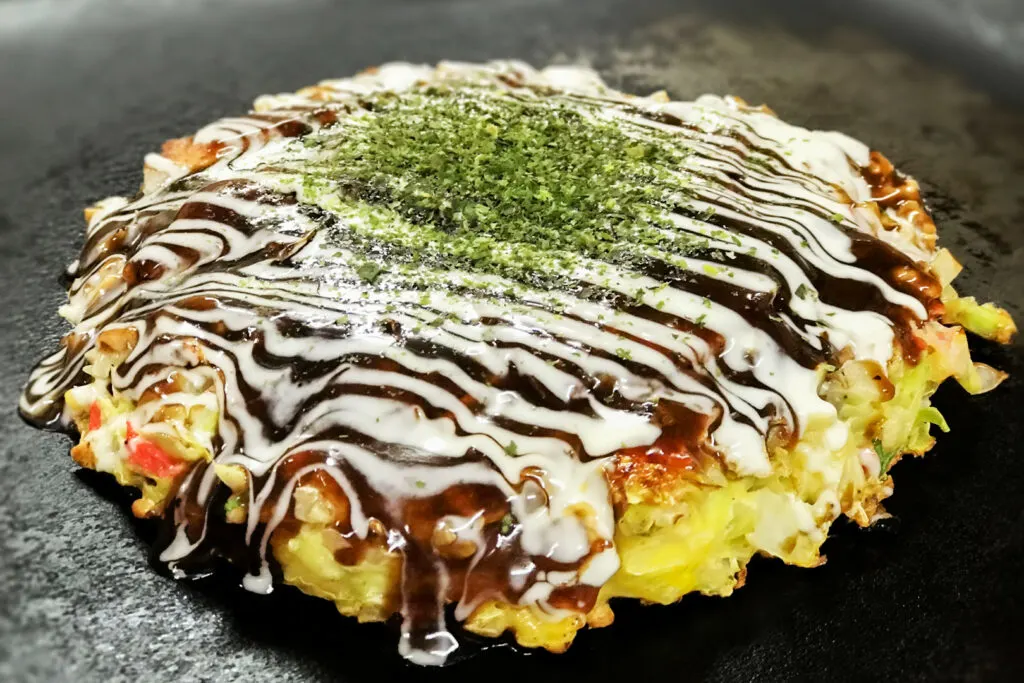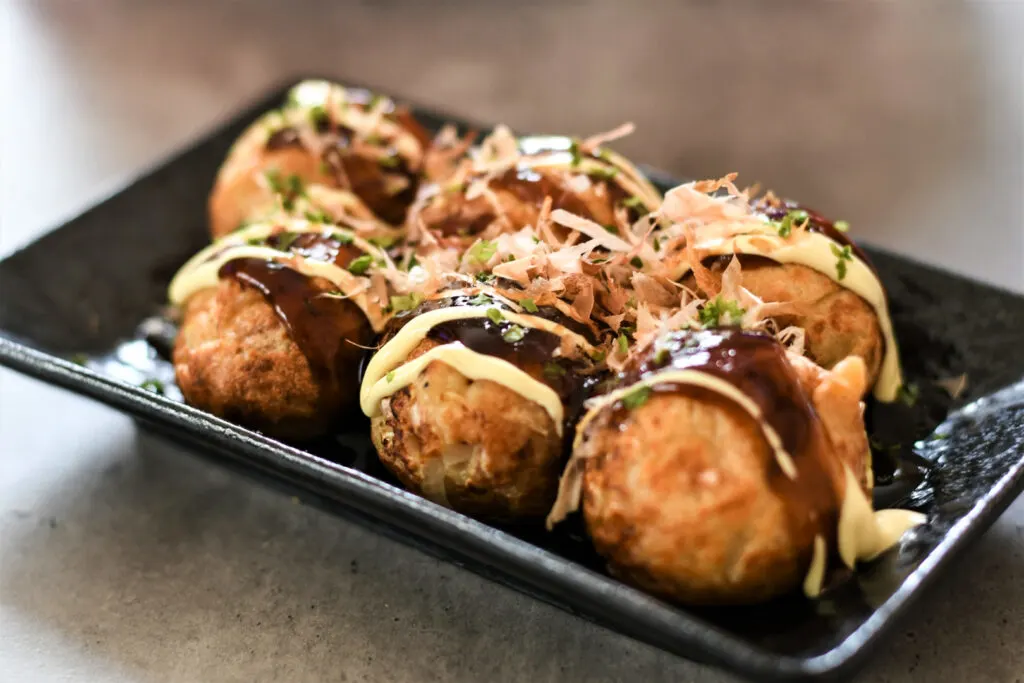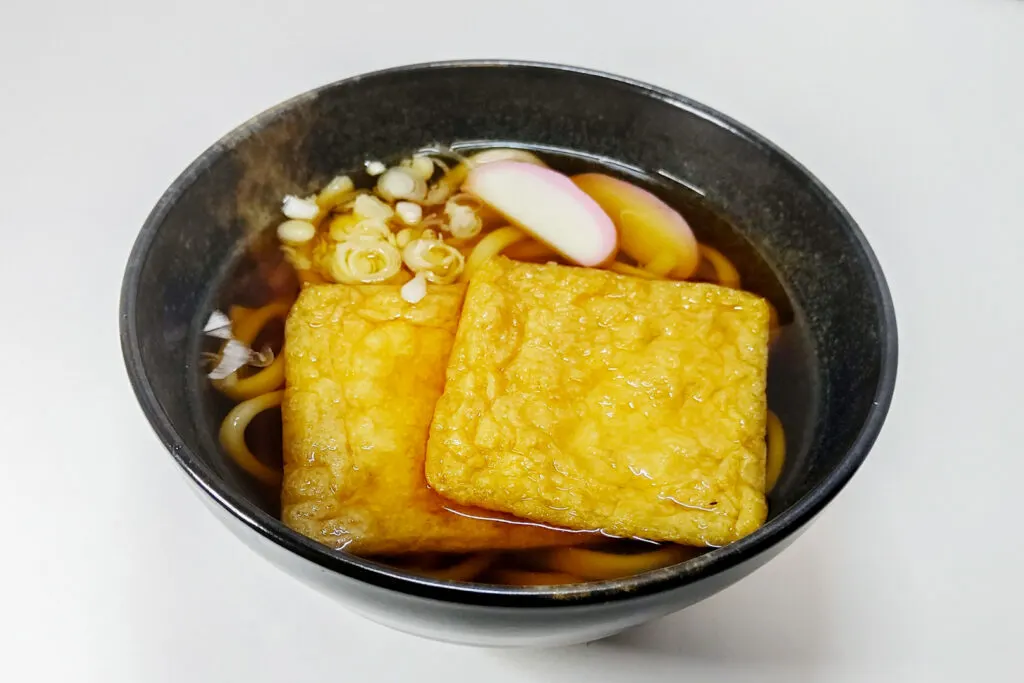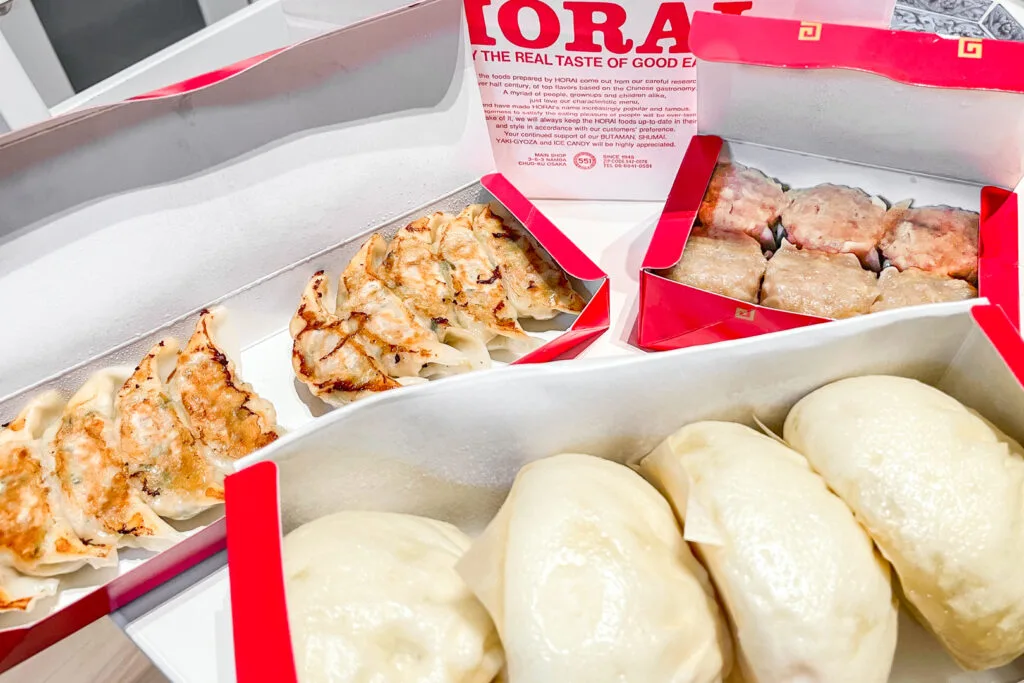In Japan, Osaka is known to be the city for foodies, particularly when it comes to comfort food. The city has so many specialties that it can be hard to decide where to start, especially when considering that many of these rich and filling dishes are budget-friendly and can be found at almost every street corner in urban areas.
But set the overwhelm aside, for this article will help you narrow down what Osaka food you’ve got to try at least once when you’re in the food capital of Japan.

Table of Contents
Osaka Food: Okonomiyaki (お好み焼き, おこのみやき)
Okonomiyaki can be likened to a savory Japanese pancake. There are two regional variations of the dish, and one of them comes from the Kansai region, where Osaka is situated. Kansai-style okonomiyaki consists of batter mixed with cabbage and other ingredients, and the best part is that you can customize it to your liking. This mixture is fried on a hot plate and then topped with a rich okonomiyaki sauce, mayonnaise, and aonori seaweed powder.

Osaka reigns supreme for Kansai-syle okonomiyaki and after moving here following ten years of living in other areas of Japan, I’m not surprised. There are tons of okonomiyaki restaurants here in Osaka, from chains to family-owned shops, and stalls called yatai (屋台, やたい). By trying different places, you can taste the differences in Kansai-style okonomiyaki, especially when it comes to the okonomiyaki flour.
I remember popping into one local restaurant called Okonomiyaki Ekimae (お好み焼き 駅前), which is run by adorable old ladies, and having the fluffiest, sweetest, most delicious okonomiyaki of my life. My husband, who happens to be Japanese, also agreed.
The portions were huge despite being only around 800 yen each and although we thought we would only eat half of it and take the rest home for dinner, we finished everything. Japanese say betsubara (別腹, べつばら, literally a “separate stomach”) when it comes to having room for dessert or your favorite food, and in this case, we had it for finishing off that okonomiyaki.
Most restaurants in Osaka have you mix and cook the okonomiyaki yourself, which is part of the experience. If you don’t know how to do it, the restaurant staff will gladly help. Otherwise, just pick up a ready-to-eat okonomiyaki from a yatai.
Takoyaki (たこ焼き, たこやき)
These delectable little balls consist of batter filled with a small piece of octopus, which are called tako (たこ) in Japanese, that are fried (yaki, 焼き, やき) on a special hot plate to form their perfectly round shape. These are drizzled with takoyaki sauce and mayonnaise and then topped with aonori and bonito flakes.

When you bite in, you’ll be greeted with a variety of textures — a little crispy but soft on the outside, hot and moist on the inside, and chewy from the octopus.
I should also mention that takoyaki can be an acquired taste. My friends from Canada who were visiting Japan were not fans of these different textures, in particular the inside of the takoyaki, as it was too “gooey” for their liking. However, it’s absolutely worth trying as this is quite a unique type of food, especially for how cheap it is from a yatai.
Like okonomiyaki, you can find takoyaki at yatai, restaurants, and even food courts in shopping malls. Restaurants like Takonotetsu will likely have you make your takoyaki yourself, which we have yet to perfect even after a year of living in Osaka. You can also customize the filling for your takoyaki, such as adding cheese, curry powder, and at some places pineapple, to the batter. The sauce is customizable as well, with options like ponzu or soy sauce with sesame or vinegar.
If you don’t like octopus, there’s no harm in just asking for tako-nashi (no octopus) takoyaki or omitting it when you make it in a restaurant. Sure this might defeat the purpose of takoyaki — the name means “fried octopus” after all — but I feel that one of the best parts of food in Osaka is that you can customize it based on your preferences. As chopped bits of octopus can be a choking hazard for toddlers, my daughter has tako-nashi takoyaki all the time!
Kushikatsu (串カツ, くしかつ)
‘Kushikatsu’ is something I always got back when I was a tourist in Osaka. The name means “skewered katsu”, katsu (かつ) being battered and fried cutlets.
With kushikatsu, you can indeed enjoy small bite-sized morsels of different kinds of katsu that are skewered, breaded, and fried, including meat like pork or beef, seafood like fish, shrimp, and scallops, as well as vegetables such as shiitake mushroom, lotus root (renkon, れんこん) and cheese and tomatoes. Some places even offer desserts such as banana kushikatsu dipped in chocolate (which isn’t for me if I’m being completely honest).

Like the other dishes mentioned in this article, kushikatsu is something you can either have cooked or fry yourself. Afterward, you dip it into a sauce as the finishing touch before eating. Of course, be sure you let it cool off! It’s simple and delicious, and you can eat as much or as little as you like. Note that the sauce is usually in a container that is shared among customers, so no double dipping allowed!
Shinsekai in Osaka is the best place to visit if you want to try kushikatsu. I recommend trying the original Kushikatsu Daruma restaurant, which is now one of the most famous kushikatsu chains in Japan.
Kitsune Udon (きつねうどん)
One of the most simple, cheap, and common types of dishes using udon (thick wheat flour noodles) is called kitsune (fox) udon.
Kitsune udon consists of udon noodles in a hot dashi broth topped with aburaage (fried tofu pouch). It is served at almost any udon shop throughout Japan, but I was surprised to learn that it originated in Osaka in 1893!

As the people of Osaka love kitsune udon, they are very particular about its broth, meaning that you’re likely to have some of the best kitsune udon in Japan by enjoying it in its hometown. For the best experience, visit the restaurant where this famous dish was born — Usamitei Matsubaya (うさみ亭マツバヤ).
Beni Shōga Ten (紅しょうが天, べにしょうがてん)
Tempura, a Japanese dish consisting of battered and fried vegetables and seafood, is known worldwide. But did you know that Osaka is known for its tempura made of red pickled ginger (beni shōga, 紅しょうが, べにしょうが)? I never even knew this existed before I moved to Osaka, and neither had my Japanese partner!
This type of tempura is called beni shōga ten and can be found in udon and soba shops, served as a topping on a bowl of hot noodles or as a side dish.

These are also served at kushikatsu restaurants, although the appearance differs depending on whether it’s tempura-style or kushikatsu. It’s quite easy to spot as the color popping through the golden fried batter is just as the first part of the name, beni, suggests — deep red.
Ikayaki (イカ焼き, いかやき)
This grilled squid snack is found throughout Japan but Osaka is known for its own unique spin on it. Typically, ikayaki is exactly as its name implies — a seasoned filet of squid (ika, いか) that is grilled (yaki, 焼き, やき) whole.
In Osaka, however, the squid is chopped up and added to a wheat flour batter alongside eggs on a hotplate. Everything is mixed together quickly and then flattened and cooked by pressing it with a hot iron plate. This pancake-like ikayaki is then brushed with a salty-sweet sauce before being folded in half like a crepe.

For those looking to taste some of the most popular ikayaki in Osaka, head to Hanshin Meibutsu Ikayaki (阪神名物いか焼き売場) in the basement of the Hanshin Department Store in Umeda. But be warned, it’s so famous that there’s usually a line!
Battera (バッテラ)
‘Battera’ is a type of pressed sushi called hakozushi (箱寿司, はこずし) made of mackerel that originated in Osaka.
This sushi consists of layered mackerel, kombu (kelp seaweed), and sushi rice that is pressed into a wooden box shaped like a boat. In fact, the name comes from the Portuguese word bateira, meaning “small boat” in reference to the appearance of the box used to press the sushi.
After the sushi is pressed, the box is turned over to remove the contents, which are then fish-side-up and sliced into rectangles before being served.
If you want to try battera, head to Sushi Tsune, which is believed to be the birthplace of this type of sushi.

Butaman (豚まん, ぶたまん)
Originally from China, butaman is a fluffy, juicy steamed pork bun that fits perfectly into your hand. It’s commonly known as nikuman (肉まん, にくまん) in most parts of Japan except for the Kansai region.
In Kansai, people refer to only beef as niku (meat), but as the filling for these buns is pork (buta), nikuman is called butaman instead.
Osaka is known for having the most flavorful and bang-for-your-buck handmade butaman. In fact, people from throughout Japan who are visiting Osaka make sure to bring home butaman as a souvenir from one particular chain restaurant that originated in Osaka called 551 Horai. While you’re there, make sure to try their other dishes, such as gyōza and shūmai dumplings.

Sakura Mochi (桜餅, さくらもち)
Sakura mochi is a popular wagashi (Japanese sweet) during cherry blossom season. The one most commonly seen throughout Japan is Kansai-style sakura mochi, also known as dōmyōji mochi (道明寺餅, どうみょうじもち).
It consists of glutinous rice that is ground into a flour called dōmyōjiko, which is mixed with sugar, food coloring, and water, shaped into a ball before being stuffed with azuki bean paste, and then wrapped in a leaf from a cherry blossom tree.
Kansai-style sakura mochi can be found almost everywhere in Japan, including at convenience stores and grocery stores, during spring.

I hope this guide has been informative and will help you narrow down what to get when you’re in Osaka! Leave a comment and let us at Japanese Food Guide know what Osaka food you want to try first or what’s your Osaka food favorite!
Pin me for later

Kay is a Canadian freelance translator and writer who has been in Japan for more than a decade. Having lived in the Chugoku, Kanto, and now the Kansai regions, she hopes to share their various local cuisine on JFG.
She also writes about her experiences being a mother in Japan on her website, Tiny Tot in Tokyo.
